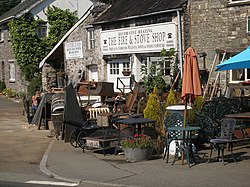Trecastle
Trecastle
|
|
|---|---|
 |
|
| Trecastle shown within Powys | |
| OS grid reference | SN929291 |
| Principal area | |
| Ceremonial county | |
| Country | Wales |
| Sovereign state | United Kingdom |
| Post town | BRECON |
| Postcode district | LD3 |
| Dialling code | 01874 |
| Police | Dyfed-Powys |
| Fire | Mid and West Wales |
| Ambulance | Welsh |
| EU Parliament | Wales |
| UK Parliament | |
| Welsh Assembly | |
Trecastle (Welsh: Trecastell) is a village in Powys, Wales, on the edge of the Brecon Beacons National Park (Parc Cenedlaethol Bannau Brycheiniog).
Trecastle ("the town of the castle") is named after Castle Tump (Trecastle Motte) an early 11th-century Norman motte-and-bailey fortification [1], built by Bernard de Neufmarche and designed to protect Brecon from attack from the west. Despite this purpose, the area continued to be threatened, with Edward I of England spending three days in Trecastle quelling a revolt in 1295. The old castle name of 'una villa nostra de Lliwel' was changed by the end of Medieval era to the local name Trecastle, "the town of the castle". The fortification still exists at the east end of the village and the motte at 6.6 m high is the largest of its type in the National Park.
From around the 12th century the Bishop of St David's owned the land to the west of the book and Trecastle was thus used as a staging post en route to the Cathedral. After leaving the stopping point the road is thought to have turned to follow the Roman Road near Y Pigwn. Centuries later, Trecastle was used by coach travellers as a stopping point on the route from Gloucester to Llandovery.
By the 19th century Trecastle had eight annual fairs, its own gasworks, two schools, a grain mill, two smithies, 16 shops and numerous pubs. Between 1830 and 1914, Trecastle and Llywel (1 mile to the west) are said to have had two of the most important wool mills in Brecknockshire. However, the arrival of a railway in Sennybridge (3 miles to the east) meant that Trecastle later lost its place as the trading centre for the area.
...
Wikipedia

